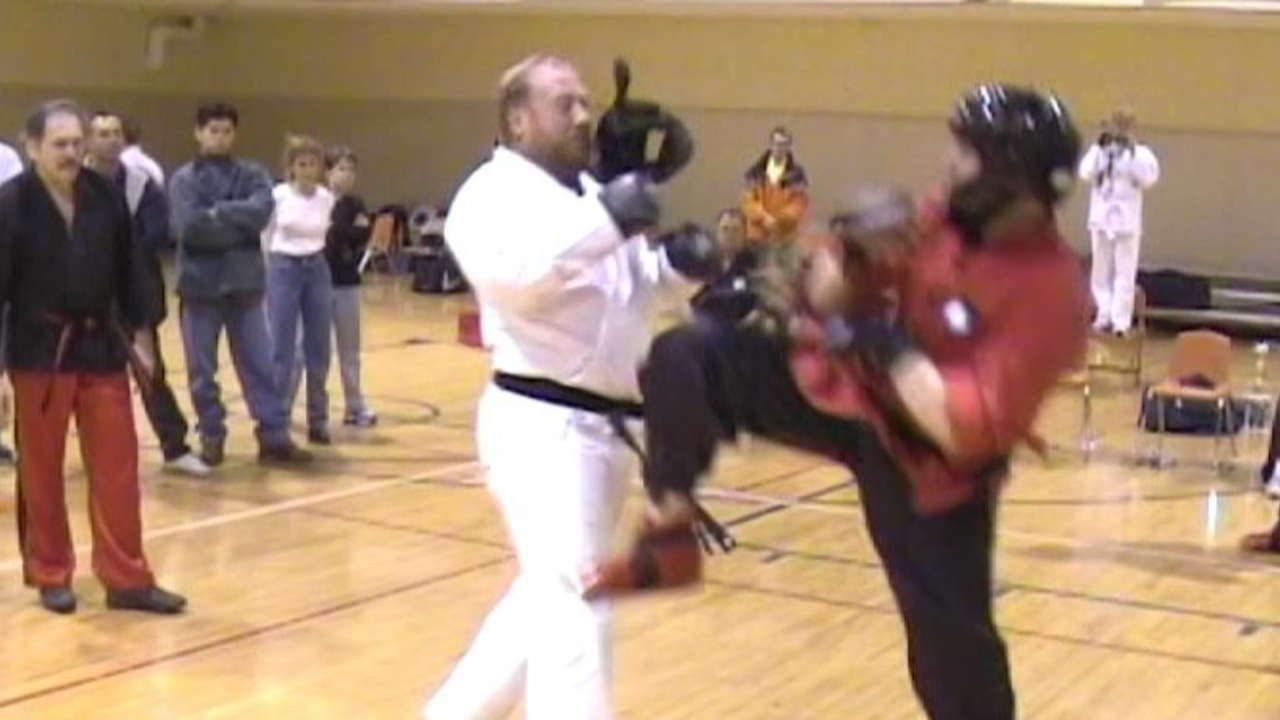Training with Bill Wallace at the Martial Arts Supershow 2010

It's funny how your life crosses path with some people in a way you couldn't have predicted.
In 1976, I was 23 years old and watching a live karate kickboxing match on TV. Bill "Superfoot" Wallace knocked out a big bald fighter with a hook kick to the head. I was so excited, I started working a lot harder at the hook kick, and it has won me many tournament matches over the years.
I first met Bill Wallace in 1982. I was a producer at WCPO-TV in Cincinnati and he came to town for an exhibition match and martial arts convention. He stopped by the station and I interviewed him.
Flash forward almost 20 years to 2001. My friend John Morrow sponsors Bill Wallace to come to do a workshop at his school here in the Quad Cities. I go to John's house and meet them and we all go out to the ice cream store. It's a summer evening and we're hanging outside an ice cream store with this martial arts superstar. I couldn't believe it. I attended the workshop and he kept using me as his dummy, showing k...
Tai Chi Instructors Should Not Throw Their Pants in the Fire

Nancy and I watch the TV series "Billions," and last night one of the characters told the story of James Davenport, an evangelist preacher back in the 1700s in the American colonies. He traveled and held revivals and preached fire and brimstone, hell and damnation.
He said he could tell if someone was "saved" or not just by looking at them.
James Davenport became known for his "Bonfire of the Vanities." He would urge his followers to throw books and other material goods into the fire. He was once charged with disorderly conduct because of his behavior and was convicted in a Hartford, Connecticut court. His punishment was simply to be sent back to his hometown.
Davenport kept preaching and holding his bonfires, and he began encouraging his followers to also throw their fancy clothes into the fire. Fancy clothes, he said, was a false god, it symbolized their vanity and kept them away from God.
One night, in front of a group of followers, he took his own pants off and threw them in...
Flowing Around Another Kung-Fu Obstacle -- a Pacemaker

The image in this post (below) might be disturbing and is a bit personal. -- FYI.
Two weeks ago, a cardiologist put a pacemaker the size of a matchbox into my chest and ran wires down into my heart.
You have to go with the flow, right?
Be water, my friend, right? Flow around obstacles and find your way.
I try to remain centered and be water, but this took me by surprise. My cardiologist and I had been talking about it for years, but the decision to do it was not made until about five days before we put the pacemaker in.
I still suffer from atrial fibrillation, also known as a-fib, and that causes my heart to beat erratically. Just sitting at my desk, or on the couch, my heart will suddenly jump from 60 beats per minute to 155 bpm, as if I am running the 100-yard dash. Then, after a few seconds it will drop to 70 beats per minute, and a couple of seconds later it will jump to 140 bpm.
This can go on for hours. It makes me tired, and if I bend over, it makes me have to breathe he...
Martial Arts Success is Laid Out For You Step by Step: Do or Do Not, the Choice is Yours

How to Maintain Your Balance in the Fearful Time of Covid-19

I lost the function of my left lung. The photo on this post shows me at Cleveland Clinic. Since then, asthma developed and during the past 11 years it has became pretty serious. I am still able to do my martial arts, but on a limited basis and I often pay a steep price.
What Does "Double-Weighted" Mean in Tai Chi?
You have heard people say that being "double-weighted" is bad in Taijiquan.
But if you ask 10 different Taiji folks what that means, you will get 10 different answers.
Some say it is when your weight is distributed 50-50 between the legs.
Some say it's a mental thing. Others say something completely different.
This video shows what I learned about double-weighting from training with Chen Xiaowang, Chen Xiaoxing and their students and disciples.
What Does Being "Double-Weighted" Mean in Tai Chi?

Has a Taiji teacher ever explained to you what "double-weighted" means? It's bad to be double-weighted, but if you are looking for a definition of the term, you will find a lot of them out there. Most of them are wrong.
Some will tell you that you are double-weighted when your weight is distributed 50-50 between the legs.
Others will say something else.
The video below demonstrates what I learned about being double-weighted from Chen Xiaowang, Chen Xiaoxing and their students (my teachers).
The Duality of Winning and Losing is a Mental Trap in Martial Arts

When I was in high school, Paul Carter's dad used to come to our track meets. I was on the team and did the high jump. Paul's dad would always say hello and talk with me a little bit. It was Lexington, Kentucky, but he grew up in the rural part of the state. He was the type of friendly Southern guy you would expect to see in Mayberry, talking with Andy Griffith.
One day Paul told me that his father enjoyed watching me high jump because, "He says whether you win or lose, you smile."
I enjoyed hearing that when I was 17. When I competed, I always wanted to do as well as I could, but I loved doing the high jump. I wasn't going to get a college track scholarship or anything. I wasn't a talented, gifted athlete, I just loved it.
A few years earlier in middle school, Coach Pieratt set out the high jump one day in gym class. None of us had ever seen it. He wanted each boy to try jumping 4 feet 10 inches. He explained to us how to jump doing the old Western Roll. The Fosbury Flop was so ne...
Patterns and Drills Evolve into Freedom in Tai Chi, Xingyi and Bagua

We worked on tea-serving exercises at practice last night and how the spiraling and the movement translates into fighting applications. The tea-serving exercises show up in the forms and in self-defense.
The ultimate goal is to develop the ability to use the spiraling concept and movement to flow with an opponent depending on what he does.
A lot of people misunderstand push hands and other practice drills like this. You put something up and they dismiss it as "won't work in a fight." Usually, they have no experience in the art, but they also can't see far enough down the road to understand that a training tool in the internal arts has one goal -- to evolve into a creative ability to flow with your opponent and not be trapped into the mindset of "I will do this technique" or "if he does this I will do that."
When you do push hands, or tea-serving, or silk-reeling exercises, you need a road map that shows you where you eventually want to be. The drill is not the thing.
Push hands, fo...
Real Self-Defense Requires Fire and Fury, Not Punch and Stop

